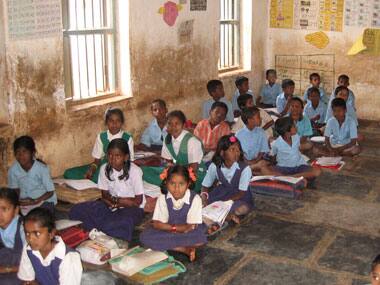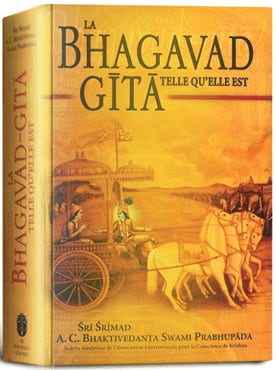The Karnataka Primary and Secondary Education minister, Vishweshwar Hegde Kageri, ruffled feathers recently by suggesting that teaching the Bhagvad Gita ought to be made compulsory in schools. To ensure his remarks were taken in the right spirit,
he added
, “The Bhagavad Gita is like the Sun. I think that it is the duty of every Indian to respect the Bhagvad Gita like they respect other elements surrounding them. I strongly feel that if someone does not respect it, they have no place in India. They should leave the country and settle abroad.” Needless to say, this modern version of the Quit India movement did not go down well in most quarters. His BJP compatriot, Dhananjay Kumar, upset his fellow panelists further on NDTV’s
The Buck Stops Here
by claiming, “Bhagvad Gita is our own Indian text, all other beliefs are foreign beliefs.” Not exactly the best way to win friends and influence people. Much of this controversy – both its incitement and the reactions it has elicited – has unfurled in predictable fashion. What is unexpected is that even Kageri’s opponents support the greater inclusion of religious texts in the classroom, albeit in a very different form. On Barkha Dutt’s show, there was much talk about a the need for “increasing knowledge of different religions,” “value-abled education,” and “rethinking our own secular shibboleths of keeping religious texts out of classrooms.” [caption id=“attachment_45843” align=“alignleft” width=“380” caption=“This moral vacuum around us cannot be filled with more classes on either the Koran, Bible or the Gita. Flickr/ Yorick_R”]
 [/caption] All of which sounded well-meaning but no less foolish. There are excellent reasons to keep religious texts out of the classroom – and many of them have less to do with a “deracinated and arid secularism” than basic common sense. Let’s start with the BJP proposal which is contradictory and hypocritical: We want to teach the Gita (and not the Koran or the Bible) because it is ‘Indian’ — but not because it’s religious since, hey, Westerners love it too. It’s true — as Kumar argues — the Bhagvad Gita has had wider resonance than other Hindu scriptures, and has been embraced by many people around the world, including the West. But then so has the Kamasutra. And that’s a true-blue Indian text — no foreign influence there! Then there’s the business about “foreigners intruding into our beliefs, and imposing their beliefs on our countrymen.” Now Kumar couldn’t name any of these ‘foreigners’, let me offer some suggestions: how about Isaac Newton, Albert Einstein, or good old Archimedes. If we must keep foreigners out of our school curriculum, let’s start with the sciences where the Westerners are clearly ruling the roost. Why limit our xenophobia expediently to moral instruction? As for the Gita itself, as Professor Chandan Gowda unhelpfully pointed out, “There’s a problem in seeing the Gita as the quintessential Hindu text.” Despite the best efforts of the Hindu high establishment to make the Gita equivalent to the Koran, Bible or the Torah, Hinduism does not include a single text that can universally represent its multitudinous forms and beliefs. There are plenty of Hindus who will be less than enchanted by the imposition of the Gita on their children. Besides whose interpretation of the Gita will we be teaching our kids: Mahatma Gandhi or Veer Savarkar? Extending the logic of the BJP error-riddled position reveals its absurdity. But instead of pointing out its glaring flaws, some of its detractors seem intent on extending the folly in a different direction. [caption id=“attachment_45867” align=“alignright” width=“276” caption=“Screen grab from gitacoaching.blogspot.com”]
[/caption] All of which sounded well-meaning but no less foolish. There are excellent reasons to keep religious texts out of the classroom – and many of them have less to do with a “deracinated and arid secularism” than basic common sense. Let’s start with the BJP proposal which is contradictory and hypocritical: We want to teach the Gita (and not the Koran or the Bible) because it is ‘Indian’ — but not because it’s religious since, hey, Westerners love it too. It’s true — as Kumar argues — the Bhagvad Gita has had wider resonance than other Hindu scriptures, and has been embraced by many people around the world, including the West. But then so has the Kamasutra. And that’s a true-blue Indian text — no foreign influence there! Then there’s the business about “foreigners intruding into our beliefs, and imposing their beliefs on our countrymen.” Now Kumar couldn’t name any of these ‘foreigners’, let me offer some suggestions: how about Isaac Newton, Albert Einstein, or good old Archimedes. If we must keep foreigners out of our school curriculum, let’s start with the sciences where the Westerners are clearly ruling the roost. Why limit our xenophobia expediently to moral instruction? As for the Gita itself, as Professor Chandan Gowda unhelpfully pointed out, “There’s a problem in seeing the Gita as the quintessential Hindu text.” Despite the best efforts of the Hindu high establishment to make the Gita equivalent to the Koran, Bible or the Torah, Hinduism does not include a single text that can universally represent its multitudinous forms and beliefs. There are plenty of Hindus who will be less than enchanted by the imposition of the Gita on their children. Besides whose interpretation of the Gita will we be teaching our kids: Mahatma Gandhi or Veer Savarkar? Extending the logic of the BJP error-riddled position reveals its absurdity. But instead of pointing out its glaring flaws, some of its detractors seem intent on extending the folly in a different direction. [caption id=“attachment_45867” align=“alignright” width=“276” caption=“Screen grab from gitacoaching.blogspot.com”]
 [/caption] Take, for instance, the response of HT Sangliana, head of the National Commission for Minorities, who claims it would be “ideal” to combine all the tenets of various religions into “wholesome textbooks” for the children. Or journalist Sadia Dahlavi who supports “greater education” so “children are more respectful of each other’s religions.” Her biggest grouse: “I know all the Hindu festivals and yet all my students and friends will keep calling to ask me, So which Id is this?” For a start, I doubt if the Delhi-based Ms Dahlavi, truly knows “all” the Hindu festivals like Sankranti or Varalakshmi Nombu. Our knowledge of other religious traditions is based on social contact outside the classroom. It’s the reason why I’ve attended Christmas Mass in church, enjoyed many a feast on Id, and have fond memories of yummy prashad at the gurudwara – but don’t have a clue about any of the Jewish holidays because all my Jewish-American friends were non-practising heathens. Besides, kids are already taught the basic tenets and traditions of all religions as part of the social sciences. Their inability to retain any memory of the same says more about our ratta system of education than glaring gaps in the curriculum. Yet another politically correct class aimed at cramming more facts isn’t likely to improve their retention level. If parents want their children to receive religious instruction, they have plenty of options. But in most cases, the family remains the best ’teacher’ a child can have. Rites, rituals, customs and beliefs vary so widely within and across religions, communities, and castes, any attempt to create a classroom curriculum that does justice to this diversity is sheer foolishness. Not to mention the political pandora’s box any such attempt will unleash. It is true that there is a greater need for a “values-based” education. Springdales principal, Ameeta Mulla Wattal, rightly points out that there is “so much alienation, so much fragmentation. The entire understanding of peace, justice and beauty has disappeared. There is a huge vacuum around us that is valueless.” But this moral vacuum cannot be filled with more classes on either the Koran, Bible or the Gita. Our children navigate their way through a materialistic culture that valorizes looks, money, and success. How about a new kind of curriculum that talks about moral puzzles our children face every day: bullying the weak; teasing those who are ‘different’; problems with self-esteem and -image; differences in status and money. I can teach my daughter the Saraswati Vandana and read her the Gita, but I could sure use some help with the rest.
[/caption] Take, for instance, the response of HT Sangliana, head of the National Commission for Minorities, who claims it would be “ideal” to combine all the tenets of various religions into “wholesome textbooks” for the children. Or journalist Sadia Dahlavi who supports “greater education” so “children are more respectful of each other’s religions.” Her biggest grouse: “I know all the Hindu festivals and yet all my students and friends will keep calling to ask me, So which Id is this?” For a start, I doubt if the Delhi-based Ms Dahlavi, truly knows “all” the Hindu festivals like Sankranti or Varalakshmi Nombu. Our knowledge of other religious traditions is based on social contact outside the classroom. It’s the reason why I’ve attended Christmas Mass in church, enjoyed many a feast on Id, and have fond memories of yummy prashad at the gurudwara – but don’t have a clue about any of the Jewish holidays because all my Jewish-American friends were non-practising heathens. Besides, kids are already taught the basic tenets and traditions of all religions as part of the social sciences. Their inability to retain any memory of the same says more about our ratta system of education than glaring gaps in the curriculum. Yet another politically correct class aimed at cramming more facts isn’t likely to improve their retention level. If parents want their children to receive religious instruction, they have plenty of options. But in most cases, the family remains the best ’teacher’ a child can have. Rites, rituals, customs and beliefs vary so widely within and across religions, communities, and castes, any attempt to create a classroom curriculum that does justice to this diversity is sheer foolishness. Not to mention the political pandora’s box any such attempt will unleash. It is true that there is a greater need for a “values-based” education. Springdales principal, Ameeta Mulla Wattal, rightly points out that there is “so much alienation, so much fragmentation. The entire understanding of peace, justice and beauty has disappeared. There is a huge vacuum around us that is valueless.” But this moral vacuum cannot be filled with more classes on either the Koran, Bible or the Gita. Our children navigate their way through a materialistic culture that valorizes looks, money, and success. How about a new kind of curriculum that talks about moral puzzles our children face every day: bullying the weak; teasing those who are ‘different’; problems with self-esteem and -image; differences in status and money. I can teach my daughter the Saraswati Vandana and read her the Gita, but I could sure use some help with the rest.
Say no to religion in schools: Why both the BJP and the liberals are wrong
Lakshmi Chaudhry
• July 22, 2011, 12:02:15 IST
The BJP wants to impose the Bhagvad Gita on schoolkids. The liberals want a multi-religious, values-based education. Here’s why neither has it right.
Advertisement
)
End of Article